Home » Kilimanjaro Packages » Shira Route
The Route is a little-used trail that begins near Shira Ridge. It is nearly identical to the Lemosho route, with Shira being the original and Lemosho the improved variation. Although Shira is a varied and beautiful route, it is less favorable than Lemosho due to the relatively high altitude of Shira’s starting point, which is accessed quickly by vehicle. Climbers may experience altitude-related symptoms on the first day while camping at 11,800 feet.
Per Person
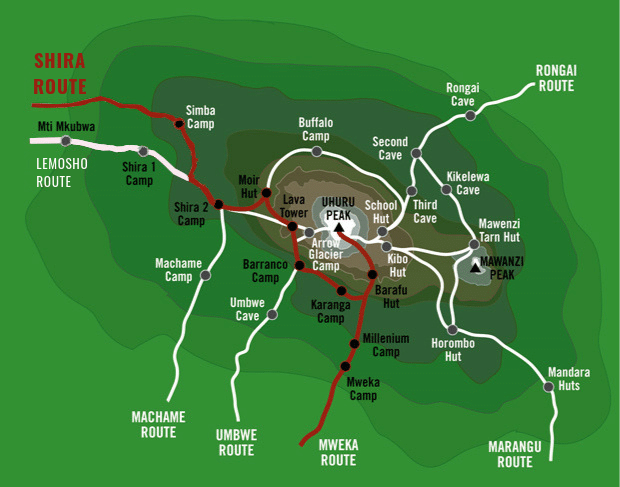
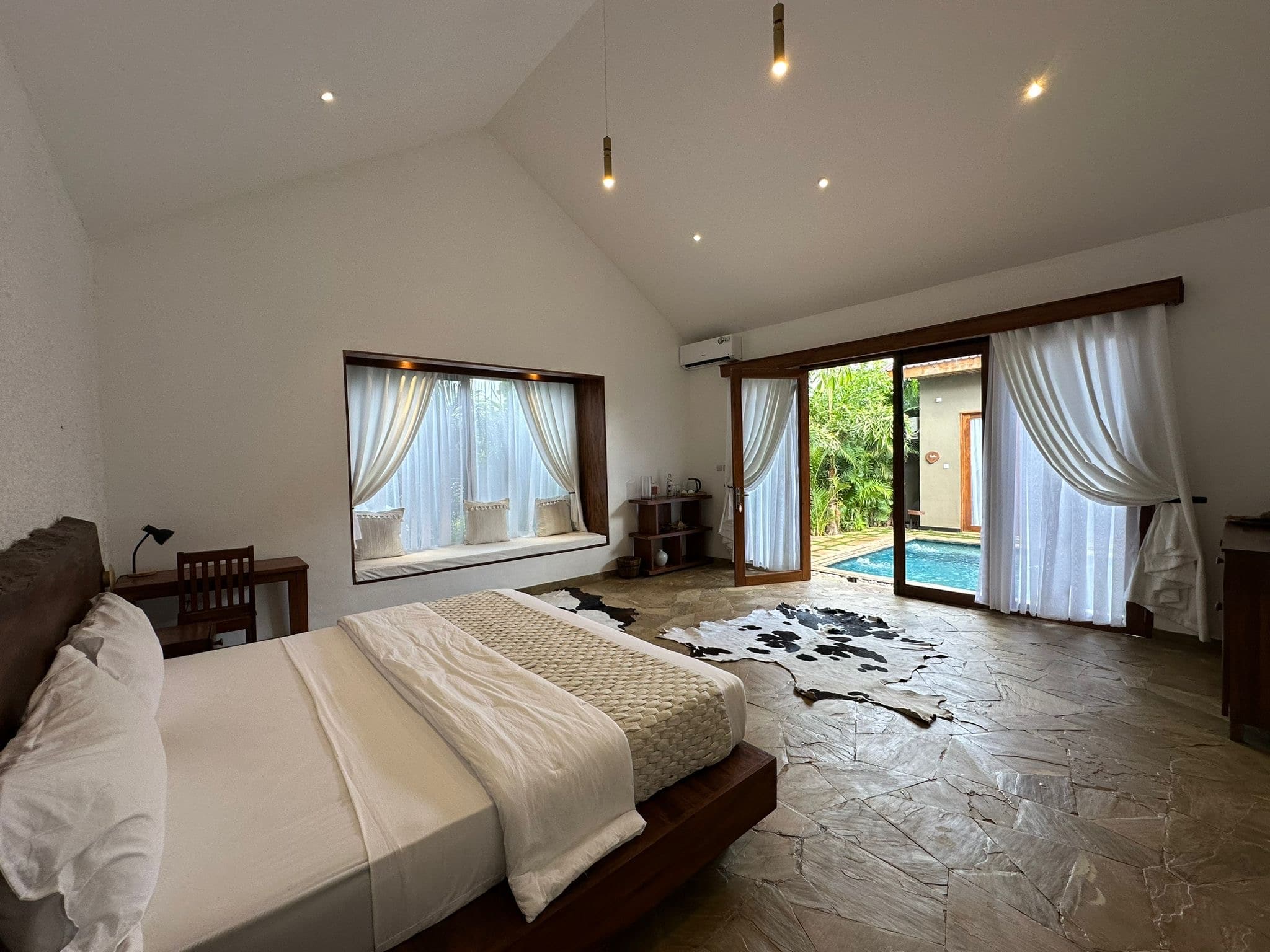
Kilimanjaro International Airport, you will be met and transferred to Tulivu Kilimanjaro Retreat for overnight accommodation. Tulivu is a quiet, spacious, clean, and comfortable boutique hotel in Kilimanjaro. The lodge offers an incredible, relaxing, and beautiful getaway. Your head guide will then meet you for your briefing, gear check, and arrangement to hire any necessary equipment.
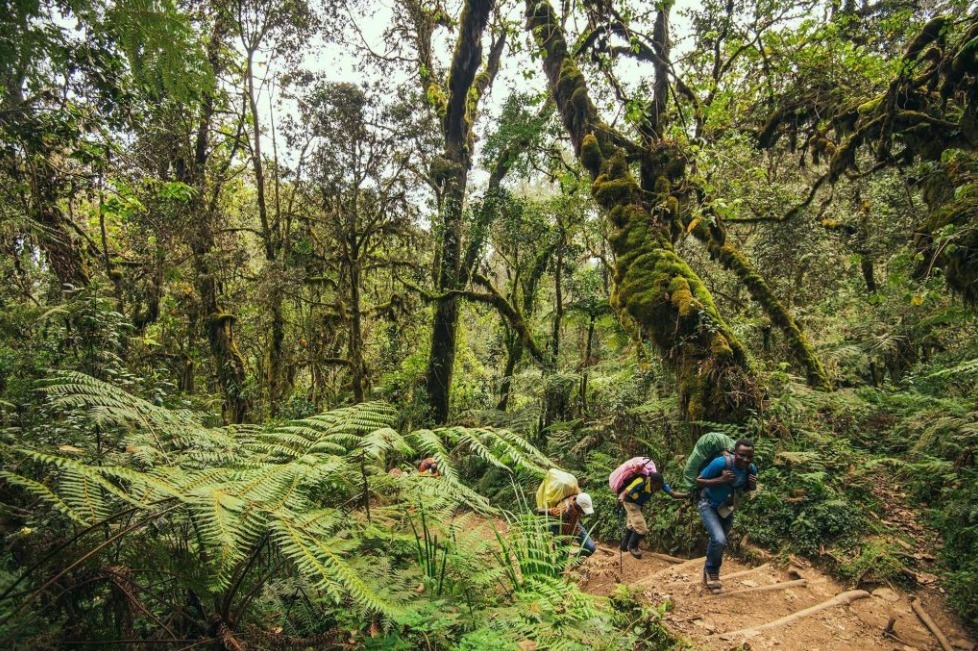
The drive from Moshi to the trailhead takes about 3 hours. We hike through the rainforest on a winding trail up a ridge. At lower elevations, the trail can be muddy and slippery. Gaiters and trekking poles are a good idea here. We continue a short distance until we reach the Shira Camp. Overnight at Shira 2 Camp.
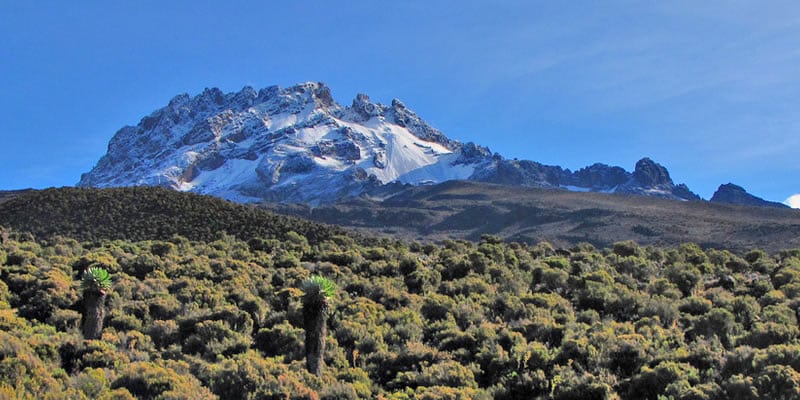
Distance: 10km/6mi
Walking Time: 5-6 hours
Habitat: Semi-desert
From the Shira Plateau, we continue to the east and up a ridge, passing the junction towards the peak of Kibo. As we continue, our direction changes to the southeast towards the Lava Tower, called the “Shark’s Tooth” (elev 4650m/15,250ft). Shortly after the tower, we come to the second junction, which goes to the Arrow Glacier. We now continue down to the Barranco Camp. Although you end the day around the same elevation as when you began, this day is significant for acclimatization. It will help your body prepare for summit day—an overnight at Barranco Camp.
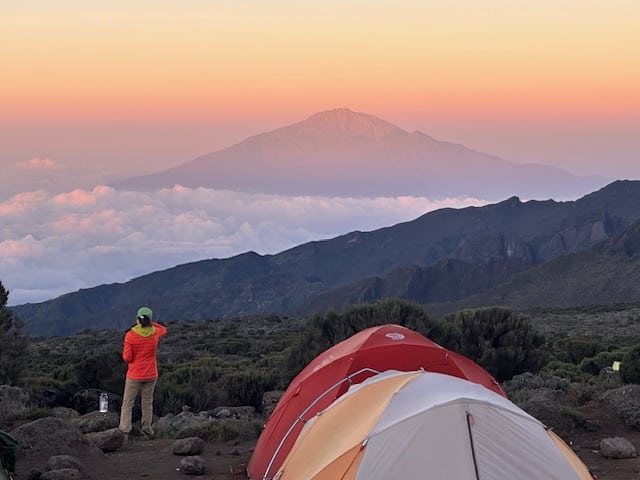
After breakfast, we leave Barranco and continue on a steep ridge up the Barranco Wall to the Karanga Valley and the junction which connects with the Mweka Trail—an overnight at Karanga Camp.
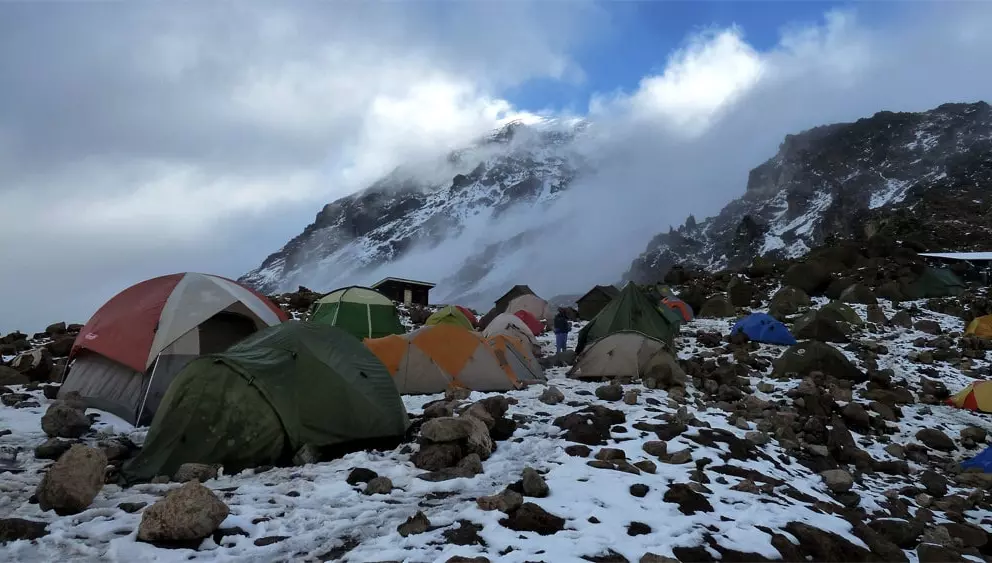
We continue up to the Barafu Camp. You have completed the South Circuit, which offers views of the summit from many angles. Here, we camp, rest, enjoy dinner, and prepare for the summit day—an overnight at Barafu Camp.
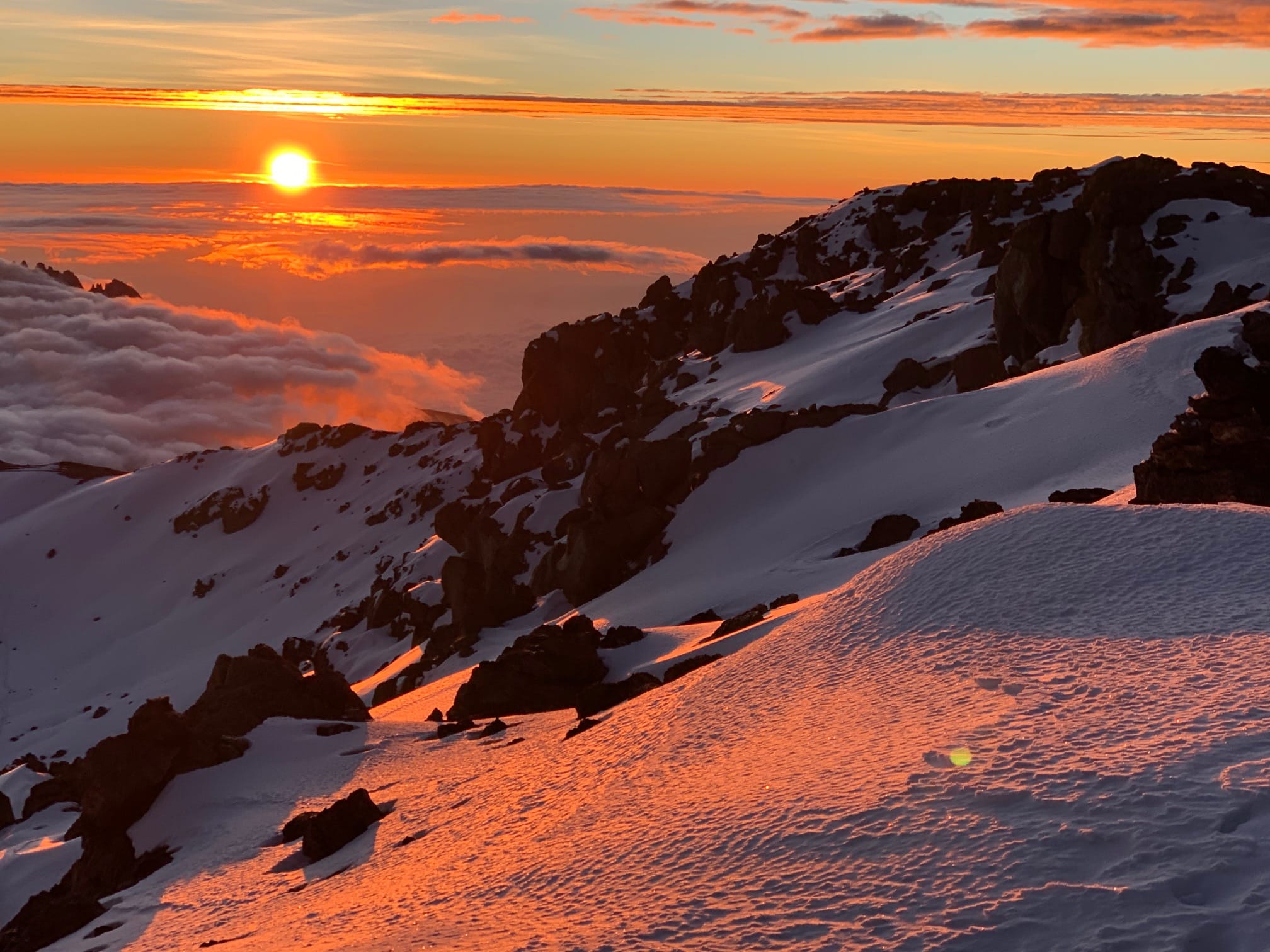
Distance: 5km/3mi up / 13km/8mi down
Hiking Time: 5-7 hours up / 5-6 hours down
Habitat: Stone scree and ice-capped summit
Very early in the morning (midnight to 2 am), we continue to the summit between the Rebmann and Ratzel glaciers. You head northwesterly and ascend through heavy scree towards Stella Point on the crater rim. This is the most mentally and physically challenging portion of the trek. At Stella Point, you will stop for a short rest and be rewarded with the most magnificent sunrise you are ever likely to see. Faster hikers may view the sunrise from the summit.
You may encounter snow on your one-hour ascent to the summit from Stella Point. Once at Uhuru Peak, you have reached the highest point on Mount Kilimanjaro and the continent of Africa!
We descend from the summit to Mweka Camp, stopping at Barafu for lunch. Because of the loose gravel, you may want gaiters and trekking poles. We arrive at Mweka Camp and enjoy our last evening on the mountain—an overnight stay.
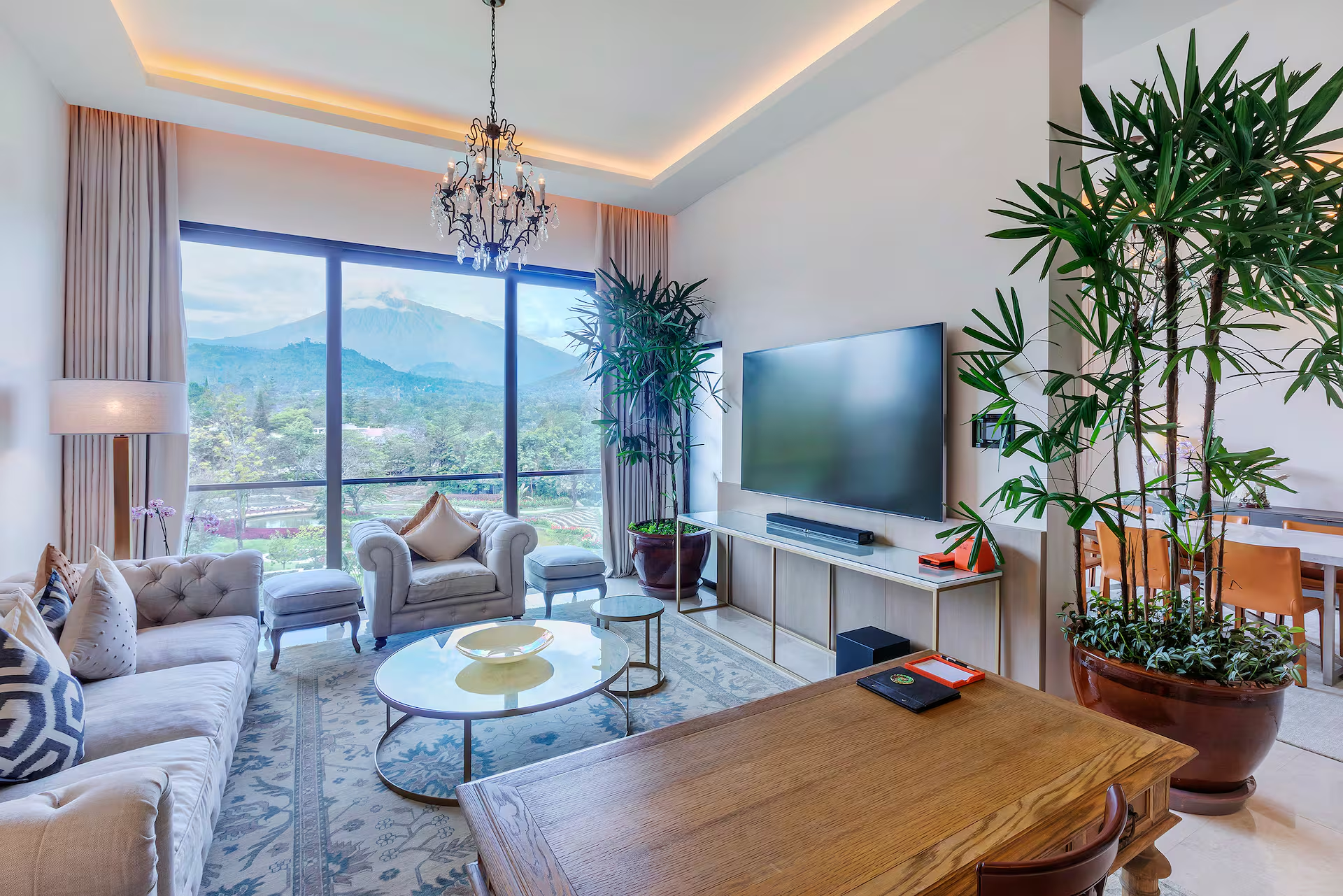
Distance: 10km/6mi
Hiking Time: 3-4 hours
Habitat: Forest
After breakfast, we will descend to the Mweka Park Gate to receive your summit certificates. At lower elevations, it can be wet and muddy, so gaiters and trekking poles will help. Shorts and T-shirts will probably be sufficient to wear, but keep rain gear and warmer clothing handy.
From the gate, continue another hour to Mweka Village. A vehicle will meet you there and drive you to your luxury accommodation in Arusha, Gran Melia Hotel.
Once you arrive, take a well-deserved hot shower and relax. Then, celebrate your successful climb with a delicious dinner and perhaps share stories and memories of your journey.
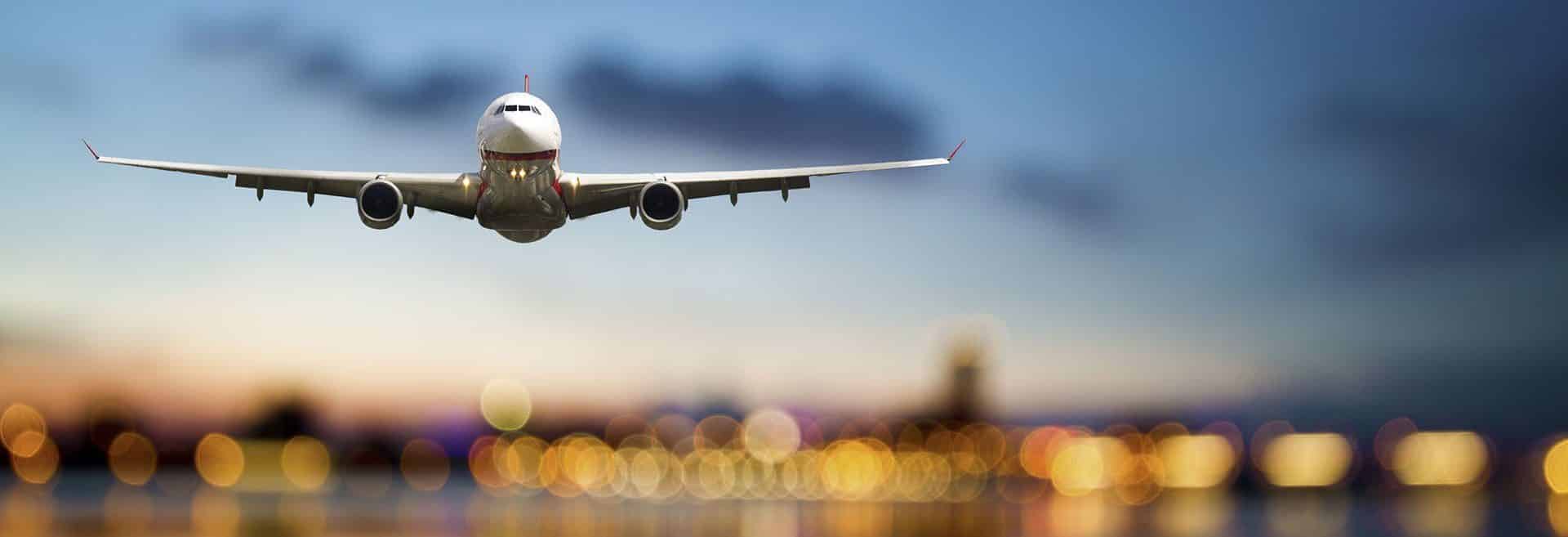
Our representative will transfer you to Kilimanjaro International Airport for your flight departure. However, take the memories, the sense of accomplishment, and the everlasting bond with the majestic Mount Kilimanjaro. But if you decide to go on a Tanzania Safari, that’s a different adventure; we’ll take care of that for you!
Kilimanjaro International Airport, you will be met and transferred to Tulivu Kilimanjaro Retreat for overnight accommodation. Tulivu is a quiet, spacious, clean, and comfortable boutique hotel in Kilimanjaro. The lodge offers an incredible, relaxing, and beautiful getaway. Your head guide will then meet you for your briefing, gear check, and arrangement to hire any necessary equipment.

The drive from Moshi to the trailhead takes about 3 hours. We hike through the rainforest on a winding trail up a ridge. At lower elevations, the trail can be muddy and slippery. Gaiters and trekking poles are a good idea here. We continue a short distance until we reach the Shira Camp. Overnight at Shira 2 Camp.

Distance: 10km/6mi
Walking Time: 5-6 hours
Habitat: Semi-desert
From the Shira Plateau, we continue to the east and up a ridge, passing the junction towards the peak of Kibo. As we continue, our direction changes to the southeast towards the Lava Tower, called the “Shark’s Tooth” (elev 4650m/15,250ft). Shortly after the tower, we come to the second junction, which goes to the Arrow Glacier. We now continue down to the Barranco Camp. Although you end the day around the same elevation as when you began, this day is significant for acclimatization. It will help your body prepare for summit day—an overnight at Barranco Camp.

After breakfast, we leave Barranco and continue on a steep ridge up the Barranco Wall to the Karanga Valley and the junction which connects with the Mweka Trail—an overnight at Karanga Camp.

We continue up to the Barafu Camp. You have completed the South Circuit, which offers views of the summit from many angles. Here, we camp, rest, enjoy dinner, and prepare for the summit day—an overnight at Barafu Camp.

Distance: 5km/3mi up / 13km/8mi down
Hiking Time: 5-7 hours up / 5-6 hours down
Habitat: Stone scree and ice-capped summit
Very early in the morning (midnight to 2 am), we continue to the summit between the Rebmann and Ratzel glaciers. You head northwesterly and ascend through heavy scree towards Stella Point on the crater rim. This is the most mentally and physically challenging portion of the trek. At Stella Point, you will stop for a short rest and be rewarded with the most magnificent sunrise you are ever likely to see. Faster hikers may view the sunrise from the summit.
You may encounter snow on your one-hour ascent to the summit from Stella Point. Once at Uhuru Peak, you have reached the highest point on Mount Kilimanjaro and the continent of Africa!
We descend from the summit to Mweka Camp, stopping at Barafu for lunch. Because of the loose gravel, you may want gaiters and trekking poles. We arrive at Mweka Camp and enjoy our last evening on the mountain—an overnight stay.

Distance: 10km/6mi
Hiking Time: 3-4 hours
Habitat: Forest
After breakfast, we will descend to the Mweka Park Gate to receive your summit certificates. At lower elevations, it can be wet and muddy, so gaiters and trekking poles will help. Shorts and T-shirts will probably be sufficient to wear, but keep rain gear and warmer clothing handy.
From the gate, continue another hour to Mweka Village. A vehicle will meet you there and drive you to your luxury accommodation in Arusha, Gran Melia Hotel.
Once you arrive, take a well-deserved hot shower and relax. Then, celebrate your successful climb with a delicious dinner and perhaps share stories and memories of your journey.

Our representative will transfer you to Kilimanjaro International Airport for your flight departure. However, take the memories, the sense of accomplishment, and the everlasting bond with the majestic Mount Kilimanjaro. But if you decide to go on a Tanzania Safari, that’s a different adventure; we’ll take care of that for you!

(+2 nights lodge)*
own room
(+2 nights lodge)*
own room
(+2 nights lodge)*
own room
(+2 nights lodge)*
own room
(+2 nights lodge)*
own room
(+2 nights lodge)*
own room
(+2 nights lodge)*
own room

5.0 out of 5
5 star
100%
4 star
0%
3 star
0%
2 star
0%
1 star
0%
We’re one of the only travel companies worldwide with perfect 5* reviews
We use only new Land Cruisers produced in 2023-2025 and fitted with a fridge, Wi-Fi and sockets
Shira Camp 1 sits at an elevation of 3,510 meters (11,516 feet), while Shira Camp 2 is located at 3,890 meters (12,760 feet) above sea level. In addition, these camps provide climbers with excellent acclimatization opportunities, helping to prepare for higher altitudes on the Kilimanjaro trek. Moreover, the gradual ascent between the two camps allows trekkers to adjust to the thinning air and avoid altitude sickness. As a result, climbers have a better chance of progressing to the summit without significant health issues. However, it is important to note that even with these acclimatization opportunities, climbers must stay mindful of their pace and hydration levels. On the other hand, those who follow the planned itinerary and take rest days will often find the journey more manageable. Therefore, Shira Camp 1 and 2 play a crucial role in preparing trekkers for the challenging days ahead.
The average elevation of the Shira Plateau is 3,600 meters (11,810 feet), with the highest point—Johnsell Point—reaching 3,962 meters (13,000 feet). As a result, this makes the Plateau one of the highest plateaus in the world. Moreover, its elevation provides unique challenges for climbers, particularly in terms of acclimatization. In addition, the plateau offers breathtaking views of Mount Kilimanjaro and the surrounding landscape. However, the thin air and high altitude can make it difficult for some trekkers to adjust quickly. On the other hand, for those who are well-prepared, the Shira Plateau is a stunning and rewarding part of the journey. Therefore, climbers should be mindful of their physical condition and take extra precautions in this high-altitude environment. Ultimately, reaching the top of the plateau is an unforgettable achievement on the road to the summit.
The Shira Route is considered moderately complex. Initially, the main challenge is that the trail begins at a high altitude of 11,500 feet, which can be dangerous for climbers who can’t acclimatize quickly. As a result, those who ascend too rapidly may experience altitude sickness. However, with proper acclimatization strategies, many climbers are able to adjust to the altitude. Additionally, the route offers stunning views and varied terrain, which helps make the challenge more rewarding. On the other hand, it’s important to pace yourself and avoid pushing too hard on the first few days. Therefore, climbers should be mindful of their bodies and take the necessary precautions to stay healthy. Ultimately, successful acclimatization is key to conquering the Shira Route safely.
Therefore, the success rate for the Shira Route varies depending on the number of days trekkers take to complete the climb:
In general, longer routes tend to provide more time for acclimatization, which, in turn, significantly increases the likelihood of reaching the summit successfully. Moreover, this extra time helps climbers adjust to the high altitudes, thus minimizing the risks associated with altitude sickness. Additionally, having a slower pace allows for better energy conservation. Furthermore, climbers on longer routes have more opportunities to rest and recover. As a result, the success rates for these longer routes are noticeably higher. Consequently, it is advisable to opt for the 7- or 8-day route if you are concerned about acclimatization. Ultimately, the more time you allow, the higher your chances of reaching Uhuru Peak!